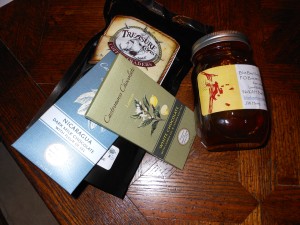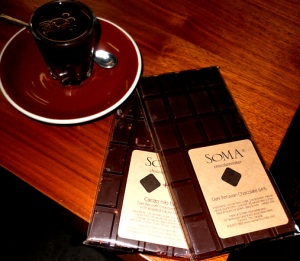You’ve got four days to get this right. Monday is Christmas, and the best gift you can give your favorite chocoholic is not that cheaply-wrapped, chemical-packed, commercially-produced drugstore special you’re about to grab off the shelf between the cereal boxes and incontinence products.
There’s time to do this right. Specialty grocery stores and markets carry the good stuff at this time of year. It’s a little late for shipping, unless you want to pay half a paycheck in shipping costs. But here are some gift ideas you can still use:
A gift certificate to Worldwide Chocolate: Not sure what they want, or how much? Get the gift that lets your recipient decide. Worldwide ships everywhere and has chocolate from every region, from bars to baking blocks, from cocoa nibs to candies, mints, squares and sampler packs. They offer vegan, gluten-free and organic products, too.
Homemade hot chocolate mix: A nice Mason jar filled with 3 1/2 cups sugar, 2 1/4 cups high-quality cocoa powder and 1 Tbsp. salt. Mix thoroughly, cover and tie with a festive ribbon. Add two mugs and instructions to use two tablespoons of mix to one cup of milk.
Look around the nicer grocery and ethnic stores. Most of the year, the high-end chocolate manufacturers aren’t as easy to find. During the holidays, you’ll find Chuao, Valrhona, Vosges, Cote d’Or, Lake Champlain and Michel Cluizel. Buy a variety of bars in different cacao percentages or with a variety of fillings, fan them out in a gift basket (the better to see the artistic labels), cover with clear wrap and a silver-flecked brown bow.
*********************************************************************
Speaking of gifts, here’s my review of two recent tastings:
Caffarel Firenze Milk Chocolate: I’d never found this Italian beauty in a local store before (hence my suggestion above to check your local groceries around the holidays). This one is milky-smooth with good vanilla undertones and not overwhelming sweetness, even at 41%. It’s a grown-up’s milk chocolate bar.
Castronovo Nicalizo Nicaragua 70% (Silver Award Winner 2017, International Chocolate Awards; Silver Award Winner 2017 Academy of Chocolate): This is 28 squares of gold-wrapped greatness, proudly wearing those two awards on the white-and-purple outside package. Who got the gold awards? Who cares! This Florida native deserves raves the moment you open it. You don’t need more than a square to appreciate the fruit and toast notes; strong but balanced. Keep every piece for yourself.



